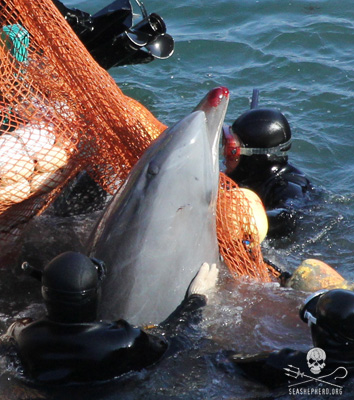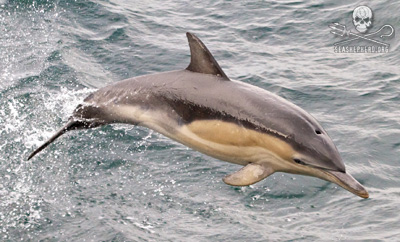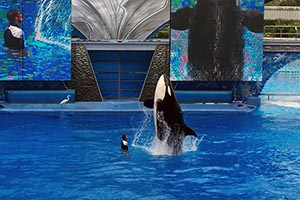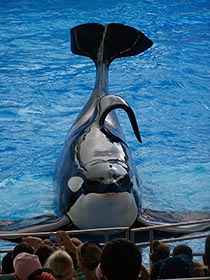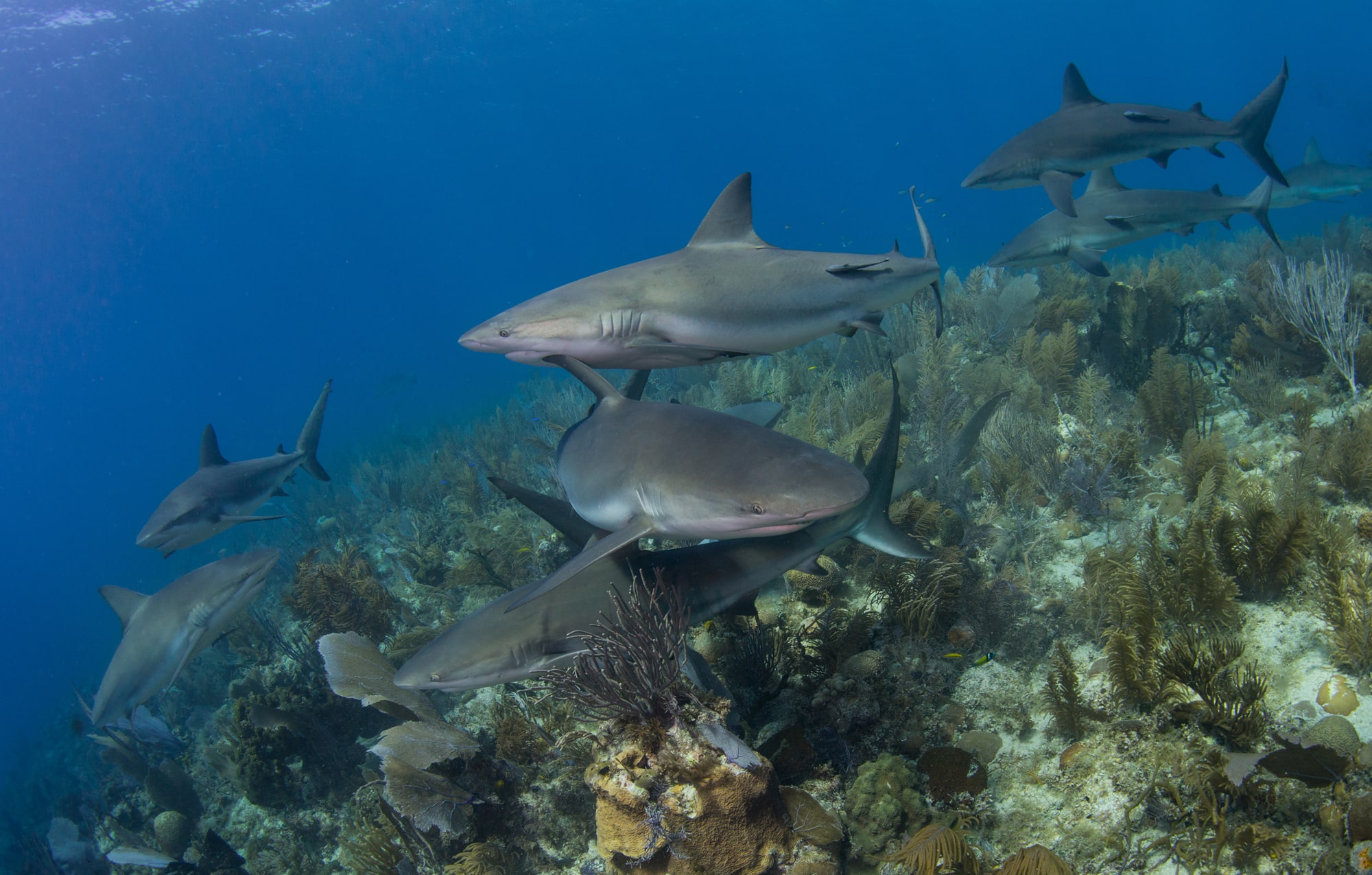Marine Life & Conservation
Latest News From Sea Shepherd
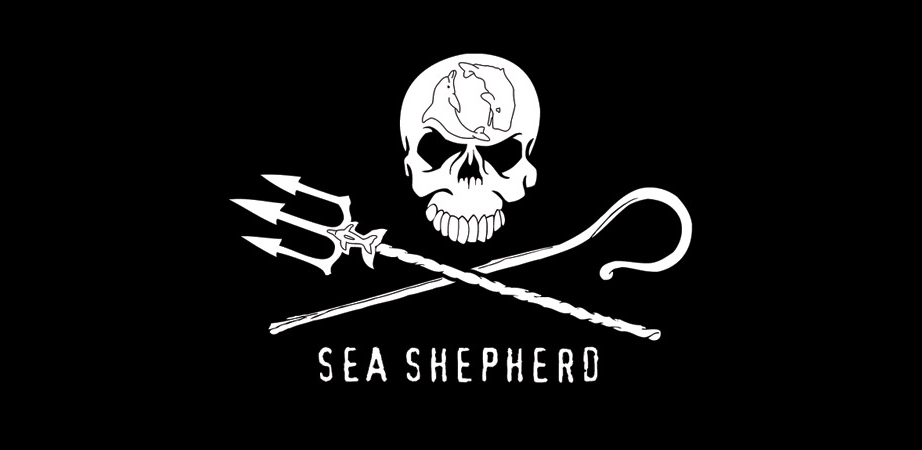
Here’s all the latest news from Sea Shepherd:
Sea Shepherd USA Invites Artists Who Have Cancelled Their SeaWorld Shows to Join the Cove Guardians in Taiji
Upon watching the disturbing film “Blackfish,” an unprecedented eight musical artists have canceled their upcoming shows at SeaWorld. Willie Nelson, Heart, Cheap Trick, Barenaked Ladies, REO Speedwagon, Trisha Yearwood, Martina McBride, and .38 Special have all canceled their shows at SeaWorld’s “Bands, Brews & BBQ” February and March concert events in response to online petitions signed by thousands of people concerned with the treatment of SeaWorld’s captive animals as depicted in the film. Joan Jett has also recently sent SeaWorld a cease and desist letter, demanding that SeaWorld’s parks stop playing her music during their orca shows. Besides personally opposing the captivity of marine wildlife, Jett was also disturbed that loud music could potentially harm these highly sound-sensitive mammals. Similarly, Edgar Winter and Tommy Lee have asked the park to remove their music from SeaWorld’s shows
Photo: Sea Shepherd
Sea Shepherd USA applauds the compassionate and informed decisions by these artists to cancel their SeaWorld concert dates. In response to these cancellations, SeaWorld has invited these artists to visit one of their parks and speak to their “animal experts” about the way their captive marine animals are treated, even calling those opposed to their captivity “animal extremists.” This is a rather harsh term to describe the multitude of sympathetic people who saw the film either in theatres or on CNN. Likening the mainstream concerns of numerous people, including these musicians, to extremism is a desperate attempt by Sea World to rationalize their practices and the captive industry.
In response to SeaWorld’s invitation, Sea Shepherd Conservation Society USA has extended an invitation to all of these artists to join the Cove Guardian volunteers currently on the ground in Taiji, Japan to witness firsthand the undeniable link between the captive marine mammal industry, of which SeaWorld is a large part, and the ongoing slaughter of dolphins and whales.
“Thousands of dolphins, porpoises and small whales are captured or killed each year in coastal towns of Japan, none more infamous than Taiji — ground zero for the worldwide captive dolphin trade. The dolphin killers and trainers work together in the killing cove to select those animals deemed ‘pretty enough’ for captivity. Those chosen are then transported to captive facilities and marine parks around the world,” said Sea Shepherd USA Administrative Director, Susan Hartland. “Despite claims from Taiji, the captive selection occurs simultaneously to the vicious killing of the rest of the pod, murdered before the eyes of their family members who see the water around them turn red with blood. Captivity undeniably funds the killing, and we want to invite these compassionate artists to see this link for themselves as they visit the Cove with our dedicated Cove Guardians.”
Photo: Sea Shepherd
The Taiji Fishermen’s Union drives entire family units, or pods, of cetaceans using banger boats and poles to create a “wall of sound” which disorients the sound-sensitive animals. Once in the deadly confines of the infamous killing cove, these families are brutally slaughtered, and their flesh is sold for meat. Juvenile and infant pod members are sometimes dumped back out at sea, where they often do not survive on their own. Each day of the hunt season, the Cove Guardians stand watch at the cove, documenting and exposing the activities of the Taiji Fishermen’s Union. When a pod is driven into the cove, the Cove Guardians livestream the drive, and captive selection or slaughter for the world to see at livestream.seashepherd.org. These volunteers are a window to Taiji, and continue to expose the link between captivity and slaughter.
The Dolphins are Not The Problem
On Tuesday, December 10th, an Alabama shrimp fisherman pled guilty to knowingly shooting a dolphin in the summer of 2012. The commercial shrimper was actively fishing in the Mississippi Sound, when he shot the dolphin with a shotgun. According to the Department of Justice, Brent Buchanan pled guilty to one misdemeanour count of knowingly taking a marine mammal protected under the Marine Mammal Protection Act, a federal crime for which he faces a maximum of one year in prison, $100,000 in fines, and a $25 special assessment.
Photo: Sea Shepherd
While his sentencing will take place on February 24, 2014, this heinous act of violence was just one in a string of dolphin attacks and killings along the GulfCoast last year. Along with several dolphins discovered with gunshot or stab wounds or severed fins and jaws, one dolphin was found alive and swimming, though impaled through the head with a screwdriver. Sea Shepherd founder Captain Paul Watson personally offered a $20,000 reward for information leading to the arrest and conviction of the person or persons responsible for these gruesome attacks on dolphins.
Most of these cases remain unsolved and are reportedly still under investigation, though it is widely suspected that many of these dolphins also fell victim to fishermen who blame the dolphins for taking “their catch” of fish. The National Oceanic and Atmospheric Association (NOAA) has expressed concern that dolphins will continue to be harmed, saying “fishermen are becoming increasingly frustrated when dolphins take their bait or catches.”
We have heard this illogical attempt at justification for violence against dolphins before. Each year, approximately 20,000 dolphins and porpoises are killed in Japanese waters, around 2,000 of which are killed in Taiji’s annual hunt. Though we know that the captive dolphin trade fuels and funds the Taiji hunt, the Taiji Fishermen’s Union, along with other dolphin hunters, claims it is because dolphins eat “their fish.” They refer to these amazing animals as “pests” who can be blamed for their declining catches. In Taiji, entire families, or pods, of cetaceans are driven by boats into the shallow waters of the infamous killing Cove, disoriented and frightened by the “wall of sound” created by banging poles. Once netted off, they will either be selected for a life imprisoned in captivity or a violent death.
Japan is not alone. In Peru, thousands of dolphins are being illegally killed and used as shark bait each year. Dolphins are used not only because their meat might be tempting to the sharks, but also because as fish populations decline due to overfishing, the cost of buying fish for bait becomes more expensive. On the Columbia River in WA/OR, Sea Lions are targeted for harassment and death and Cormorants being harassed for eating fish and taking the blame for the decline in the numbers of fish that humans are claiming rights to.
Photo: Gary Stokes / Sea Shepherd
We reacted in shock over the GulfCoast dolphin killings, and rightfully so. Hopefully the investigations that have followed will lead to some level of justice. But while we care about dolphins harmed here in the United States, what about the dolphins being brutally and senselessly killed elsewhere? Will we not act on those crimes against nature? We tend to think of the earth’s oceans as separate bodies of water, but they are all connected as one ocean, and that ocean connects all life. We have international agencies that are supposed to be providing protections and management, but they are ineffective at best. While there are agreements in place, meant to protect ocean wildlife, these agreements are not always put into action and go unenforced. The time is now for an international agency that will take action and enforce protections for imperiled ocean life and recognize our responsibility for our impact on the oceans.
Is Taiji’s hunt the price that dolphins should pay simply for eating fish that they need to survive? Should sea lions at the Bonneville Dam be captured, branded, and even killed simply for eating salmon? Those are the same salmon, by the way, who humans are fishing, and who are being killed by the dam itself.
The oceans are absolutely being overfished. That is undeniable. There is a deadly predator whose insatiable appetite and greed are depleting the oceans of life. That predator is not a dolphin, a sea lion, or a shark. Through the devastating effects of overfishing, pollution, trash, ship traffic and so many other man-made impacts, humans are taking a bigger toll on ocean wildlife than any other animal, and we are taking more than the oceans can possibly lose.
CALL TO ACTION: On February 24, 2014, Brent Buchanan will stand before Chief Magistrate Judge John M. Roper of the United States District Court for the Southern District of Mississippi for sentencing. Please contact Judge Roper, using the contact information below, with a polite request that Buchanan face the maximum penalty for his violent act toward a dolphin.
The Honorable Chief Magistrate Judge John Roper
United States District Court for the Southern District of Mississippi
2012 15th Street, Suite 870
Gulfport, MS 39501
Telephone: 228-563-1779
Email: roper_chambers@mssd.uscourts.gov
A Reply to Sea World’s Open Letter and an Invitation to Make a Meaningful New Year’s Resolution
The documentary “Blackfish” has left a desperate SeaWorld in its wake, struggling to stay afloat in a sea of bad press and criticism from the public. As performer after performer (eight total, so far) cancels their scheduled show for SeaWorld’s upcoming “Bands, Brews & BBQ” concert series due to concerns raised by the film, SeaWorld has fought back with a list of responses that they have called an open letter from SeaWorld’s “animal advocates.” While their representatives have declined to share how much money was spent putting this response out there, it is almost certain that SeaWorld spent thousands of dollars getting the letter published in eight major U.S. newspapers.
If you have read the letter, you might be finding it hard to separate fact from fiction as it is filled with SeaWorld’s spin on the captive marine mammal industry. Sea Shepherd would like to present a few counterpoints to SeaWorld’s arguments that will hopefully clear up any confusion.
“SeaWorld does not capture killer whales in the wild. Due to the groundbreaking success of our research in marine mammal reproduction, we haven’t collected a killer whale from the wild in 35 years.”
While SeaWorld admits that they have two orcas in their “care” who were captured in the wild, they leave out the violent and traumatic captures that these orcas endured. Footage of a notoriously brutal orca capture in Penn Cove, a capture which tore apart a family of orcas and left some dead, can be seen in “Blackfish.” Those responsible for the capture even sank the bodies of the dead whales in an effort to hide their deaths.
Tilikum’s capture took place off the coast of Iceland in 1983, when he was only 2. He was sent to SeaLand of the Pacific, before enduring a stressful transport once again to his current prison, SeaWorld Orlando.
Many of SeaWorld’s orcas were, indeed, born in captivity. Many of them are the offspring of Tilikum, who is used as SeaWorld’s breeding machine. SeaWorld’s marine mammals are often inbred, offspring of two mated members of the same family, resulting in a range of genetic abnormalities and mutations. That is the truth of SeaWorld’s “groundbreaking success” in marine mammal reproduction.
The letter also conveniently leaves out the fact that SeaWorld plans to take some of the 18 wild-caught beluga whales that the Georgia Aquarium is currently fighting so hard to get their hands on. Some of the belugas would be split between SeaWorld Orlando, San Antonio, and San Diego as well as other captive facilities. Why does SeaWorld support the captures of members of a healthy population of beluga whales from the wild, while claiming publicly that their orcas don’t come from the ocean?
“We do not separate killer whale moms and calves. SeaWorld recognizes the important bond between mother and calf. On the rare occasion that a mother killer whale cannot care for the calf herself, we have successfully hand raised and reintroduced the calf. Whales are only moved to maintain a healthy social structure.”
As you can see in “Blackfish,” SeaWorld has in fact removed calves from their mother’s side and transported them to their other parks. Just as any mother would mourn for her child, the orcas have cried out long-range vocals looking for their young, taken by SeaWorld.
Even if this is old footage, it is quite possible that SeaWorld continues this practice. They continue to breed marine mammals, including orcas. Some are transferred between facilities to breed or to perform. In the wild, orcas live in large pods, and in some populations, calves stay with their mother for their entire life.
Regardless, the way to “maintain a healthy social structure” for orcas, animals who live in matriarchal pods, is never to separate a mother from her calf.
“We give our animals restaurant-quality fish, exercise, veterinary care, mental stimulation, and the company of other members of their species.”
The “restaurant-quality fish” being served to these orcas refers to thawed dead fish, contrary to their natural hunting behaviour in the wild. These fish are filled with antibiotics and vitamins to combat the effects of captivity on these often stressed, sick whales.
Wild orcas get moisture from the fish that they consume, but the frozen fish provided at SeaWorld have lost most of the moisture they once contained. So, SeaWorld feeds its orcas massive amounts of gelatine each day for hydration.
While some of these orcas may be kept with members of their species, these artificial pods are not the families that they would live with in the wild. Tilikum often remains alone, and now spends most of his time floating listlessly at the surface of his tank. He is used as a “stud” for SeaWorld’s continuous supply of captive and in-bred orcas (perversely, marine park staff masturbate males in order to collect their semen, which is used to impregnate females), and occasionally he is forced to provide the “big splash” at the end of SeaWorld’s performances. The in-breeding has led to unhealthy offspring and many babies have been stillborn.
“SeaWorld’s killer whales’ life spans are equivalent with those in the wild.”
This is a lie that SeaWorld has been feeding to the public for years. They claim “no one knows for sure how long orcas live,” a claim that has been refuted by marine biologists and orca researchers who have spent the greater part of their careers studying the lives and natural behaviours of orcas in the wild.
SeaWorld’s claim that the life spans of captive and wild orcas are comparable is shattered by the real numbers. In the wild, the average life span for males is 30 years and 50 years for females. Males can reach an estimated maximum age of 60-70 years old, and females 80-90 years old. While SeaWorld points out “five of our animals are older than 30, and one of our whales is close to 50,” this is highly unusual for orcas in captivity, including those at SeaWorld. Many die before those ages, and some even before reaching maturity.
“The killer whales in our care benefit those in the wild. We work with universities, governmental agencies and NGOs to increase the body of knowledge about and the understanding of killer whales — from their anatomy and reproductive biology to their auditory abilities.”
SeaWorld’s “research” on their captive orcas benefitting wild orcas is a stretch, to say the least. Captive orcas are mere shells of their wild counterparts, unable even to engage in the most basic of their natural behaviors or live in their natural social groupings. The collapsed dorsal fin that you see in captive orcas is something that SeaWorld claims is also common in the wild, but in fact is rarely seen in wild orcas. It is a sign of stress, illness, injury or other conditions.
“SeaWorld is a world leader in animal rescue. The millions of people who visit our parks each year make possible SeaWorld’s world-renowned work in rescue, rehabilitation and release…We have rescued more than 23,000 animals with the goal of treating and returning them to the wild.”
While SeaWorld does rescue, rehabilitate and release ocean wildlife, this statement included in their letter is disgracefully misleading. The animals released by SeaWorld are most often manatees, sea turtles, and other animals who cannot be used as “performers” in their shows. Dolphins and whales and other animals such as sea lions rescued by SeaWorld who can be forced to perform tricks for food are kept and used as performers.
We have yet to hear conclusive findings on the actual success of SeaWorld’s rescue and release program. They do not follow up and report on the survival of the animals who have been released from their care.
In addition, according to its 2011-12 Annual Report, SeaWorld has given only $9 million dollars over the last decade toward conservation efforts. That means for every 100 dollars in revenue they bring in, they donate approximately 1 cent toward saving the animals in the wild whose captive counterparts they are exploiting. That’s .0001 percent of their income going to help animals in the wild. I think that might be the most telling point of all — that, in fact, SeaWorld is really nothing more than a money-making enterprise.
The bottom line is that SeaWorld is part of the massive machine that is the captive marine mammal industry, an industry willing to spew whatever lies it can in order to keep you spending your money at their parks. This industry is inextricably linked not only to the deaths of the animals in their tanks, but to the deaths of marine mammals brutally slaughtered in Taiji, Japan where dolphin trainers work side-by-side with dolphin killers to hand-pick those who are suitable for captivity – those who are “prettiest” and without visible scars. SeaWorld does not want you to know what “Blackfish” made so clear, and what our volunteer Cove Guardians continue to show on the ground in Taiji every day: captivity kills.
As that message spreads, a new generation is leading the way for a future of freedom for marine life. Children have begun to speak out and say that they will never spend another moment at SeaWorld or other marine parks that hold orcas and other dolphins and whales in captivity. Students have even gotten regular school trips to SeaWorld cancelled.
Children may have small voices, but they also have powerful voices because they represent change. This may be the hardest hit to SeaWorld yet, as these future adults will usher in the end of support for the captive industry and a shift toward protecting marine mammals where they belong — in the wild.
To find out more about Sea Shepherd, click here.
Marine Life & Conservation
Double Bubble for Basking Sharks

 The Shark Trust is excited to announce that, for two more days only, all donations, large or small, will be doubled in the Big Give Green Match Fund!
The Shark Trust is excited to announce that, for two more days only, all donations, large or small, will be doubled in the Big Give Green Match Fund!
Donate to Basking in Nature: Sighting Giants
The Shark Trust is hoping to raise £10k which will be doubled to £20k. This will go towards Basking in Nature: Sighting Giants. And they need YOUR help to reach they’re goal.
The Shark Trust’s citizen science project is to monitor and assess basking sharks through sightings; encouraging data collection, community engagement, and promoting nature accessibility. This initiative aims to enhance health and wellbeing by fostering a deeper connection with British Sharks.
Campaign Aims
- Increase citizen science reporting of Basking Sharks and other shark sightings to help inform shark and ray conservation.
- Provide educational talks about the diverse range of sharks and rays in British waters and accessible identification guides!
- Create engaging and fun information panels on how to ID the amazing sharks and rays we have on our doorstep! These can be used on coastal paths around the Southwest. With activities and information on how you can make a difference for sharks and rays!
- Promote mental wellbeing through increasing time in nature and discovering the wonders beneath the waves!
Donate, and double your impact. Click Here
Marine Life & Conservation
Leading UK-based shark conservation charity, the Shark Trust, is delighted to announce tour operator Diverse Travel as a Corporate Patron
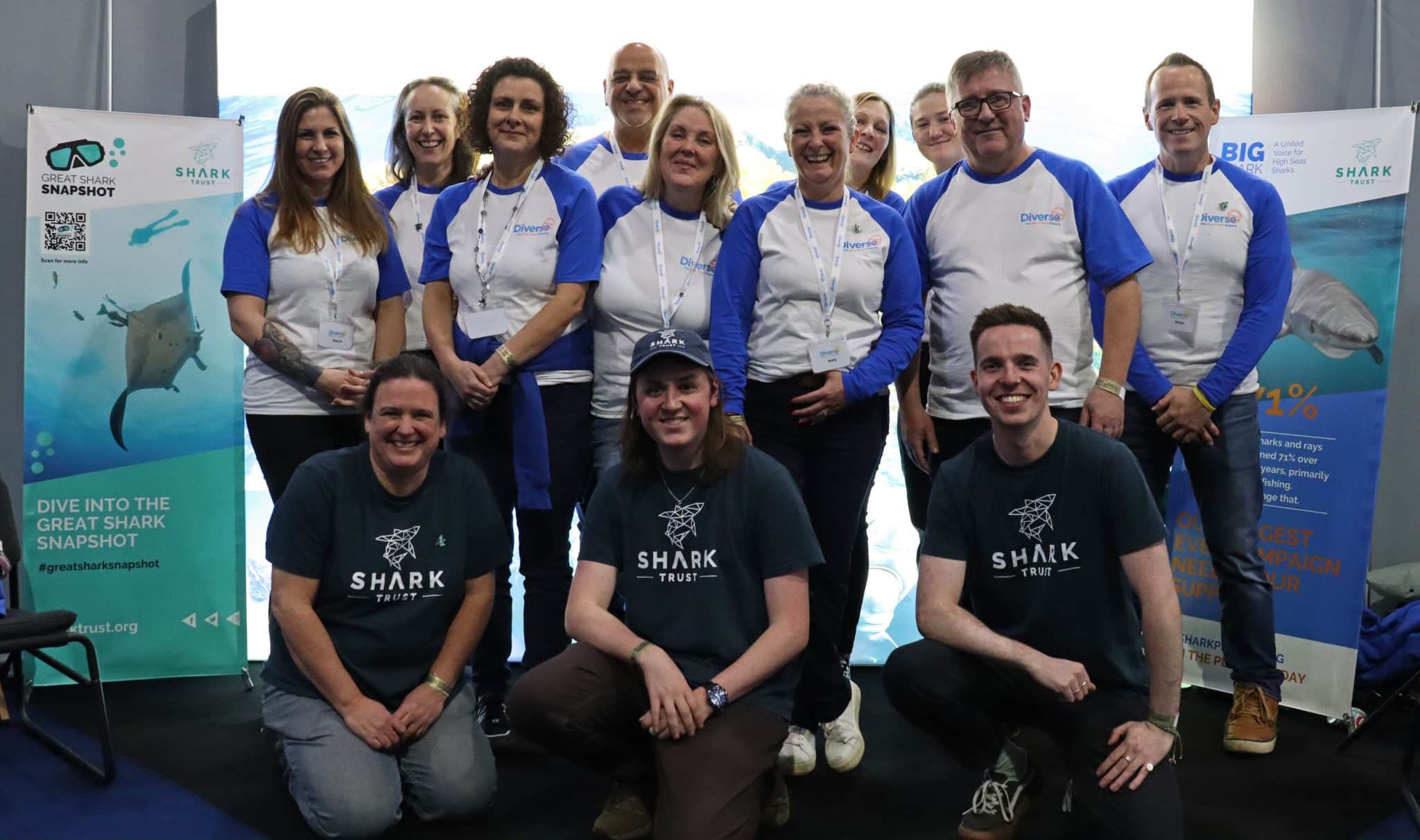
 Corporate Patrons provide a valuable boost to the work of The Shark Trust. The Trust team works globally to safeguard the future of sharks, and their close cousins, the skates and rays, engaging with a global network of scientists, policymakers, conservation professionals, businesses and supporters to further shark conservation.
Corporate Patrons provide a valuable boost to the work of The Shark Trust. The Trust team works globally to safeguard the future of sharks, and their close cousins, the skates and rays, engaging with a global network of scientists, policymakers, conservation professionals, businesses and supporters to further shark conservation.
Specialist tour operator Diverse Travel has operated since 2014 and is committed to offering its guests high quality, sustainable scuba diving holidays worldwide. Working together with the Shark Trust will enable both organisations to widen engagement and encourage divers and snorkellers to actively get involved in shark conservation.
“Sharks are truly at the heart of every diver and at Diverse Travel, we absolutely share that passion. There is nothing like seeing a shark in the wild – it’s a moment that stays with you forever!” says Holly Bredin, Sales & Marketing Manager, Diverse Travel.
“We’re delighted to celebrate our 10th year of business by becoming a Corporate Patron of the Shark Trust. This is an exciting partnership for Diverse and our guests. We will be donating on behalf of every person who books a holiday with us to contribute towards their vital shark conservation initiatives around the world. We will also be working together with the Trust to inspire divers, snorkellers and other travellers to take an active role – at home and abroad – in citizen science projects and other activities.”
Paul Cox, CEO of The Shark Trust, said:
“It’s an exciting partnership and we’re thrilled to be working with Diverse Travel to enable more divers and travellers to get involved with sharks and shark conservation. Sharks face considerable conservation challenges but, through collaboration and collective action, we can secure a brighter future for sharks and their ocean home. This new partnership takes us one more valuable step towards that goal.”
For more information about the Shark Trust visit their website here.
For more about Diverse Travel click here.
-

 News3 months ago
News3 months agoHone your underwater photography skills with Alphamarine Photography at Red Sea Diving Safari in March
-

 News3 months ago
News3 months agoCapturing Critters in Lembeh Underwater Photography Workshop 2024: Event Roundup
-

 Marine Life & Conservation Blogs2 months ago
Marine Life & Conservation Blogs2 months agoCreature Feature: Swell Sharks
-

 Blogs2 months ago
Blogs2 months agoMurex Resorts: Passport to Paradise!
-

 Blogs2 months ago
Blogs2 months agoDiver Discovering Whale Skeletons Beneath Ice Judged World’s Best Underwater Photograph
-

 Gear Reviews2 months ago
Gear Reviews2 months agoGear Review: Oceanic+ Dive Housing for iPhone
-

 Marine Life & Conservation2 months ago
Marine Life & Conservation2 months agoSave the Manatee Club launches brand new webcams at Silver Springs State Park, Florida
-

 News3 months ago
News3 months agoWorld’s Best Underwater Photographers Unveil Breathtaking Images at World Shootout 2023




